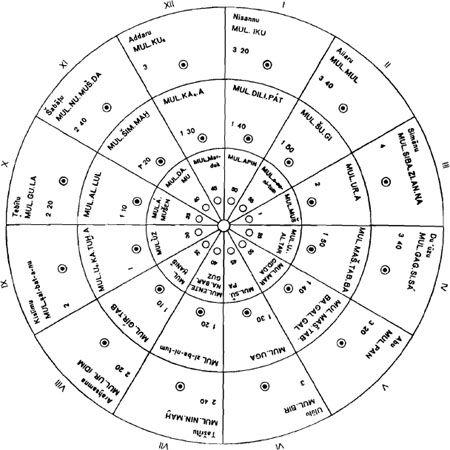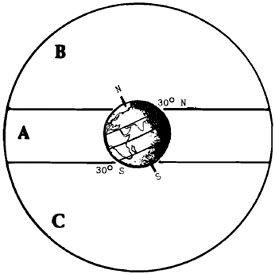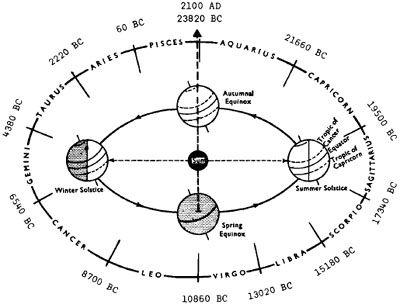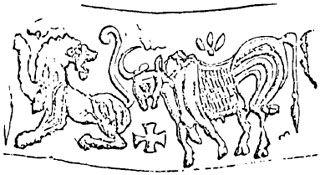The 12th Planet (31 page)
Authors: Zecharia Sitchin
Tags: #Non-Fiction, #Gnostic Dementia, #Fringe Science, #Retail, #Archaeology, #Ancient Aliens, #History

The Way of Ea posed serious problems to the Assyriologists who undertook the immense task of unraveling the ancient astronomical knowledge not only in terms of modern knowledge but also based on what the skies should have looked like centuries and millennia ago. Observing the southern skies from Ur or Babylon, the Mesopotamian astronomers could see only a little more than halfway into the southern skies; the rest was already below the horizon. Yet, if correctly identified, some of the constellations of the Way of Ea lay well beyond the horizon. But there was an even greater problem: If, as the scholars assumed, the Mesopotamians believed (as the Greeks did in later times) that Earth was a mass of dry land resting upon the chaotic darkness of a netherworld (the Greek Hades)—a flat disc over which the heavens arched in a semicircle—then there should have been no southern skies at all!
Restricted by the assumption that the Mesopotamians were beholden to a flat-Earth concept, modern scholars could not permit their conclusions to take them too much below the equatorial line dividing north and south. The evidence, however, shows that the three Sumerian "ways" encompassed the complete skies of a global, not flat, Earth.
1900 T. G. Pinches reported to the Royal Asiatic Society that he was able to reassemble and reconstruct a complete Mesopotamian astrolabe (literally, "taker of stars"). He showed it to be a circular disc, divided like a pie into twelve segments and three concentric rings, resulting in a field of thirty-six portions. The whole design had the appearance of a rosette of twelve "leaves," each of which had the name of a month written in it. Pinches marked them I to XII for convenience, starting. with Nisannu, the first month of the Mesopotamian calendar. (Fig. 94)
Each of the thirty-six portions also contained a name with a small circle below it, signifying that it was the name of a celestial body. The names have since been found in many texts and "star lists" and are undoubtedly the names of constellations, stars, or planets.
Each of the thirty-six segments also had a number written below the name of the celestial body. In the innermost ring, the numbers ranged from 30 to 60; in the central ring, from 60 (written as "I") to 120 (this "2" in the sexagesimal system meant 2 X 60 = 120); and in the outermost ring, from 120 to 240. What did these numbers represent?
Writing nearly fifty years after the presentation by Pinches, the astronomer and Assyriologist O. Neugebauer
(A History of Ancient Astronomy: Problems and Methods)
could only say that "the whole text constitutes some kind of schematic celestial map . . . in each of the thirty-six fields we find the name of a constellation and simple numbers whose significance is not yet clear." A leading expert on the subject, B. L. Van der Waerden
(Babylonian Astronomy: The Thirty-Six Stars),
reflecting on the apparent rise and fall of the numbers in some rhythm, could only suggest that "the numbers have something to do with the duration of daylight."

Fig. 94
The puzzle can be solved, we believe, only if one discards the notion that the Mesopotamians believed in a flat Earth, and recognizes that their astronomical knowledge was as good as ours—not because they had better instruments than we do, but because their source of information was the Nefilim.
We suggest that the enigmatic numbers represent degrees of the celestial are, with the North Pole as the starting point, and that the astrolabe was a planisphere, the representation of a sphere upon a flat surface.
While the numbers increase and decrease, those in the opposite segments for the Way of Enlil (such as Nisannu—50, Tashritu—40) add up to 90; all those for the Way of Anu add up to 180; and all those for the Way of Ea add up to 360 (such as Nisannu 200, Tashritu 160). These figures are too familiar to be misunderstood; they represent segments of a complete spherical circumference: a quarter of the way (90 degrees), halfway (180 degrees), or full circle (360 degrees).
The numbers given for the Way of Enlil are so paired as to show that this Sumerian segment of the northern skies stretched over 60 degrees from the North Pole, bordering on the Way of Anu at 30 degrees above the equator. The Way of Anu was equidistant on both sides of the equator, reaching to 30 degrees south below the equator. Then, farther south and farthest away from the North Pole, lay the Way of Ea—that part of Earth and of the celestial globe that lay between 30 degrees south and the South Pole. (Fig. 95)
The numbers in the Way of Ea segments add up to 180 degrees in Addaru (February–March) and Ululu (August–September). The only point that is 180 degrees away from the North Pole, whether you go south on the east or on the west, is the South Pole. And this can hold true only if one deals with a sphere.
Precession is the phenomenon caused by the wobble of Earth's north-south axis, causing the North Pole (the one pointing at the North Star) and the South Pole to trace a grand circle in the heavens. The apparent retardation of Earth against the starry constellations amounts to about fifty seconds of an arc in one year, or one degree in seventy-two years. The grand circle—the time it takes the Earth's North Pole to point again at the same North Star—therefore lasts 25,920 years (72 X 360), and that is what the astronomers call the Great Year or the Platonian Year (for apparently Plato, too, was aware of the phenomenon).
The rising and setting of various stars deemed significant in antiquity, and the precise determination of the spring equinox (which ushered in the New Year), were related to the zodiacal house in which they occurred. Due to the precession, the spring equinox and the other celestial phenomena, being retarded from year to year, were finally retarded once in 2,160 years by a full zodiacal house. Our astronomers continue to employ a "zero point" ("the first point of Aries"), which marked the spring equinox circa 900
B.C.
, but this point has by now shifted well into the house of Pisces. Circa
A.D.
2100 the spring equinox will begin to occur in the preceding house of Aquarius. This is what is meant by those who say that we are about to enter the Age of Aquarius. (Fig. 96).
Because the shift from one zodiacal house to another takes more than two millennia, scholars wondered how and where Hipparchus could have learned of the precession in the second century
B.C.
It is now clear that his source was Sumerian. Professor Langdon's findings reveal that the Nippurian calendar, established circa 4400
B.C.
, in the Age of Taurus, reflects knowledge of the precession and the shift of zodiacal houses that took place 2,160 years
earlier
than that. Professor Jeremias, who correlated Mesopotamian astronomical texts with Hittite astronomical texts, was also of the opinion that older astronomical tablets recorded the change from Taurus to Aries; and he concluded that the Mesopotamian astronomers predicted and anticipated the shift from Aries to Pisces.

Fig. 95.
THE CELESTIAL SPHERE
A. The Way of Anu, the celestial band of the Sun, planets and the constellations of the Zodiac
B. The way of Enlil, the northern skies
C. The Way of Ea, the southern skies

Fig. 96
Subscribing to these conclusions, Professor Willy Hartner
(The Earliest History of the Constellations in the Near East)
suggested that the Sumerians left behind plentiful pictorial evidence to that effect. When the spring equinox was in the zodiac of Taurus, the summer solstice occurred in the zodiac of Leo. Hartner drew attention to the recurrent motif of a bull–lion "combat" appearing in Sumerian depictions from earliest times, and suggested that these motifs represented the key positions of the constellations of Taurus (Bull) and Leo (Lion) to an observer at 30 degrees north (such as at Ur) circa 4000
B.C.
(Fig. 97)

Fig. 97
Most scholars consider the Sumerian stress of Taurus as their first constellation as evidence not only of the antiquity of the zodiac—dating to circa 4000
B.C.
—but also as testifying to the time when Sumerian civilization so suddenly began. Professor Jeremias
(The Old Testament in the Light of the Ancient East)
found evidence showing that the Sumerian zodiacal-chronological "point zero" stood precisely between the Bull and the Twins; from this and other data he concluded that the zodiac was devised in the Age of Gemini (the Twins)—that is, even
before
Sumerian civilization began. A Sumerian tablet in the Berlin Museum (VAT.7847) begins the list of zodiacal constellations with that of
Leo
-taking us back to circa 11,000
B.C.
, when Man had just begun to till the land.
Professor H. V. Hilprecht
(The Babylonian Expedition of the University of Pennsylvania)
went even farther. Studying thousands of tablets bearing mathematical tabulations, he concluded that "all the multiplication and division tables from the temple libraries of Nippur and Sippar, and from the library of Ashurbanipal [in Nineveh] are based upon [the number] 12960000." Analyzing this number and its significance, he concluded that it could be related only to the phenomenon of the precession, and that the Sumerians knew of the Great Year of 25,920 years.
This is indeed fantastic astronomical sophistication at an impossible time.
